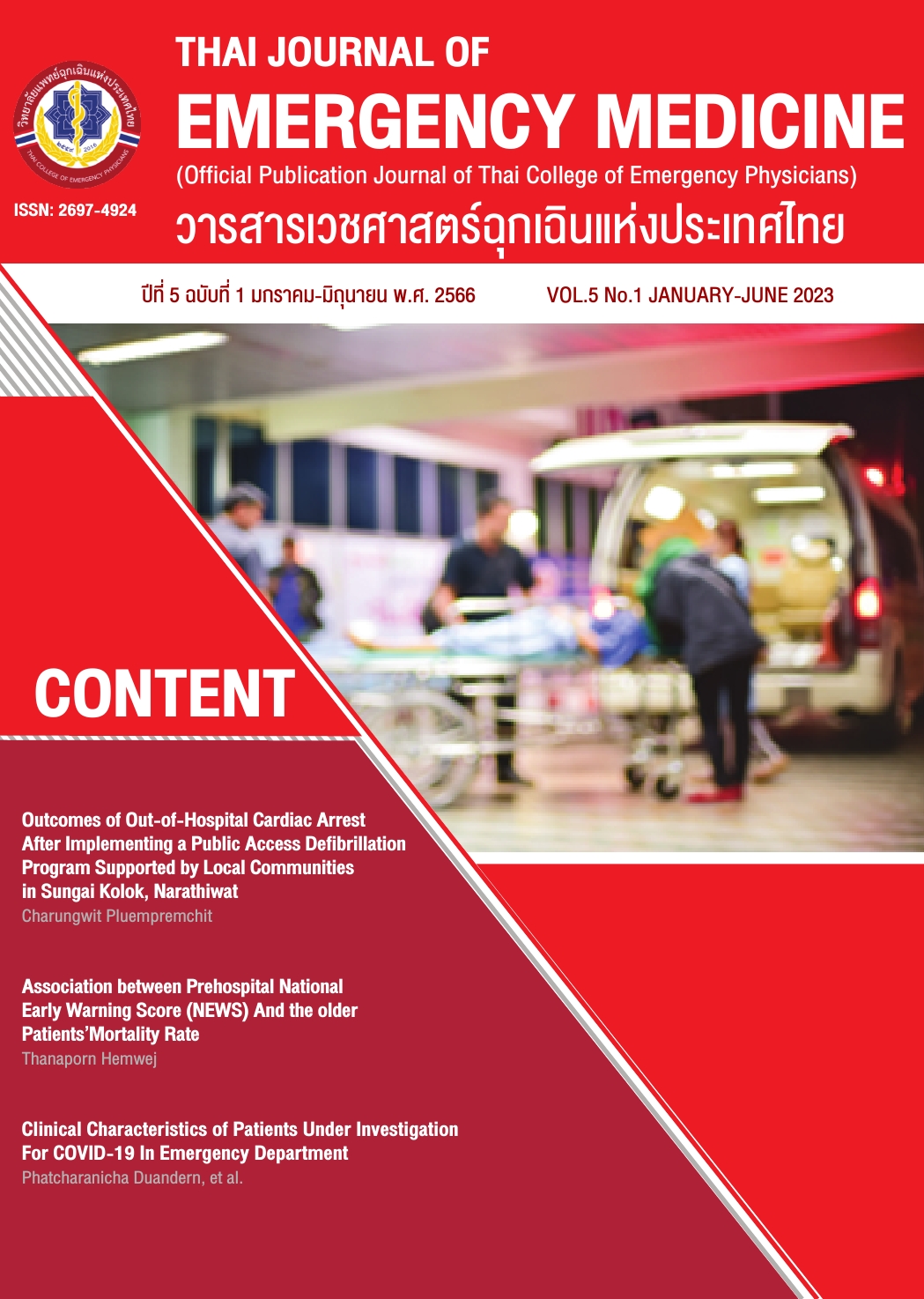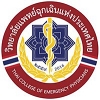Outcomes of Out-of-Hospital Cardiac Arrest After Implementing a Public Access Defibrillation Program Supported by Local Communities in Sungai Kolok, Narathiwat
Keywords:
mobile AED, fixed location AED, survival to dischargeAbstract
Introduction
Out of hospital cardiac arrest (OHCA) often involves shockable rhythms treatable with automated external defibrillator (AED), is in the chain of survival. Su-ngaikolok residents have recognized and implemented AED according to the guidelines of the public access defibrillation program.
Objective
This study analyzes OHCA cases before and after AED installation, AED usage patterns, survival rates of OHCA patients in Su-ngaikolok district.
Methods
OHCA patient data was retrospectively collected, comparing cases before (n=67) and after (n=91) AED installation from October 2016 to February 2022. Statistical analysis employed chi-square tests and independent t-tests.
Results
The sample (n = 158) mainly comprised males, aged over 60 years, with incidents occurring at home. Initial cardiac rhythms were predominantly asystole or pulseless electrical activity (PEA). Comparing before and after AED installation, there were significant associations with advanced life support ambulance transportation, witness transports, responder AED training and onset to AED (p-value < .05). Survival rates showed improvement: return of spontaneous circulation (ROSC) from 37.3% to 46.2% (p-value .266), survival to admission from 28.4% to 29.7% (p-value .858) and survival to discharge from 1.5% to 7.7% (p-value .078) respectively. Following AED installation, the usage rate was 49.5%, with mobile AEDs accounting for 93.3% and fixed location AEDs 6.7%, corresponding to usage rates of 10.5 and 0.075 times per year, respectively. When comparing variables affecting survival to discharge, it was found that AED usage patterns, CPR duration and initial cardiac rhythms (asystole, PEA 14.29%, ventricular tachycardia, ventricular fibrillation 85.71%) have a statistically significant ( p-value < .05).
Conclusions:
AED usage. Using a mobile AED yields 140 times higher than fixed location Proper installation in suitable locations is crucial for successful OHCA response.
References
สมาคมแพทย์โรคหัวใจแห่งประเทศไทย. คู่มือการช่วยชีวิตขั้นสูง ACLS provider manual: สำหรับ บุคลากรทางการแพทย์ ปี ค.ศ. 2020. พิมพ์ครั้งที่ 1. กรุงเทพฯ: ชมรมคณะกรรมการมาตรฐานการช่วยชีวิต สมาคมแพทย์โรคหัวใจแห่งประเทศไทย ในพระบรมราชูปถัมภ์; 2564.
Kumor S, Chow C and Jan S. Rapid literature review on public access to defibrillation. Newtown : NSW ministry of health; 2018.
กลุ่มยุทธศาสตร์แผนและประเมินผล กองโรคไม่ติดต่อ กรมควบคุมโรค กระทรวงสาธารณสุข. รายงานประจำปี 2563. กรุงเทพฯ: สำนักพิมพ์อักษร กราฟฟิคแอนด์ดีไซน์; 2564
Kiguchi T, Okubo M, Nishiyama C, Maconochie I, Ong MEH, Kern KB, et al. Out-of-hospital cardiac arrest across the World: First report from the International Liaison Committee on Resuscitation (ILCOR). Resuscitation. 2020 Jul; 152:39–49.
Luo Z, Zong Q, Chen S, Lv C. The global survival rate among adult out-of-hospital cardiac arrest patients who received cardiopulmonary resuscitation: a systematic review and meta-analysis. Crit care. 2020 Feb 22;24(1):61. doi:10.1186/s13054-020-2773-2. PMID:32087741.
Tekeyuki k, Masashi O, Chika N, Ian M, Marcus O, Karl B. K, et al. Out-of-hospital cardiac arrest across the World: First report from the International Liaison Committee on Resuscitation (ILCOR). Resuscitation(clinical paper) 2020 (cited 2019 November4); 5(152). Available from:https://www.elsevier.com/locate/resuscitation
Aeby D, Staeger P, Dami F. How to improve automated external defibrillator place ment for out-of-hospital cardiac arrests: A case study. PLOS ONE. 2021 May 20;16(5): e0250591.
Tierney NJ, Reinhold HJ, Mira A, Weiser M, Burkart R, Benvenuti C, et al. Novel relocation methods for automatic external defibrillator improve out-of-hospital cardiac arrest coverage under limited resources. Resuscitation. 2018 Apr; 125:83–9.
Leung K, Lui C, Cheung K, Tsui K, Tang Y. Outcome and Prognostic Factors of Patients in Out-Of-Hospital Cardiac Arrests Presenting with Non-Shockable Rhythm in Hong Kong. Hong Kong J Emerg Med. 2012 Jan 1;19(1):6–12.
Llongueras Espi P, Pons Monne M, Salvans Cirera M, Graterol Torres F, Singh M, Ramos Polo R, et al. Mobile versus fixed automated external defibrillators (AED deployment in a geographically dispersed population: analysis of the girona territori cardioprotegit project. Eur Heart J. 2021 Oct 1;42(Supplement_1): ehab724.1544.
Nelson RD, Bozeman W, Collins G, Booe B, Baker T, Alson R. Mobile Versus Fixed Deployment of Automated External Defibrillators in Rural EMS. Prehospital Disaster Med. 2015 Apr;30(2):152–4.
Downloads
Published
How to Cite
Issue
Section
Categories
License
Copyright (c) 2023 Thai Collage of Emergency Physicians

This work is licensed under a Creative Commons Attribution-NonCommercial-NoDerivatives 4.0 International License.
บทความที่ได้รับตีพิมพ์ในวารสารเวชศาสตร์ฉุกเฉินแห่งประเทศไทย ถือเป็นเป็นลิขสิทธิ์ของ วิทยาลัยแพทย์เวชศาสตร์ฉุกเฉินแห่งประเทศไทย
กรณีที่บทความได้รับการตีพิมพ์ในวารสารเวชศาสตร์ฉุกเฉินแห่งประเทศไทยแล้ว จะตีพิมพ์ในรูปแบบอิเล็กทรอนิกส์ ไม่มีสำเนาการพิมพ์ภายหลังหนังสือเผยแพร่เรียบร้อยแล้ว ผู้นิพนธ์ไม่สามารถนำบทความดังกล่าวไปนำเสนอหรือตีพิมพ์ในรูปแบบใดๆ ที่อื่นได้ หากมิได้รับคำอนุญาตจากวารสารเวชศาสตร์ฉุกเฉินแห่งประเทศไทย




